Financial Performance Analysis of UK-Based Companies: A Report
VerifiedAdded on 2020/02/05
|16
|4302
|76
Report
AI Summary
This report provides a comprehensive financial performance analysis of Games Workshop Plc and Character Group Plc, two UK-based companies. It utilizes ratio analysis, including profitability, liquidity, efficiency, and solvency ratios, to assess their financial health and performance trends. The analysis covers the years 2015 and 2016, offering insights into gross profit margins, net profit margins, return on assets, and return on equity. The report also discusses the role of auditors and changes in audit reports according to UK standards. Furthermore, it applies investment appraisal techniques, specifically the Internal Rate of Return (IRR), to evaluate project viability for Trump Manufacturing, offering recommendations on whether to invest. The analysis includes stock market performance comparisons, highlighting share price fluctuations and investor sentiment for both companies.

ONLINE TEST
Paraphrase This Document
Need a fresh take? Get an instant paraphrase of this document with our AI Paraphraser
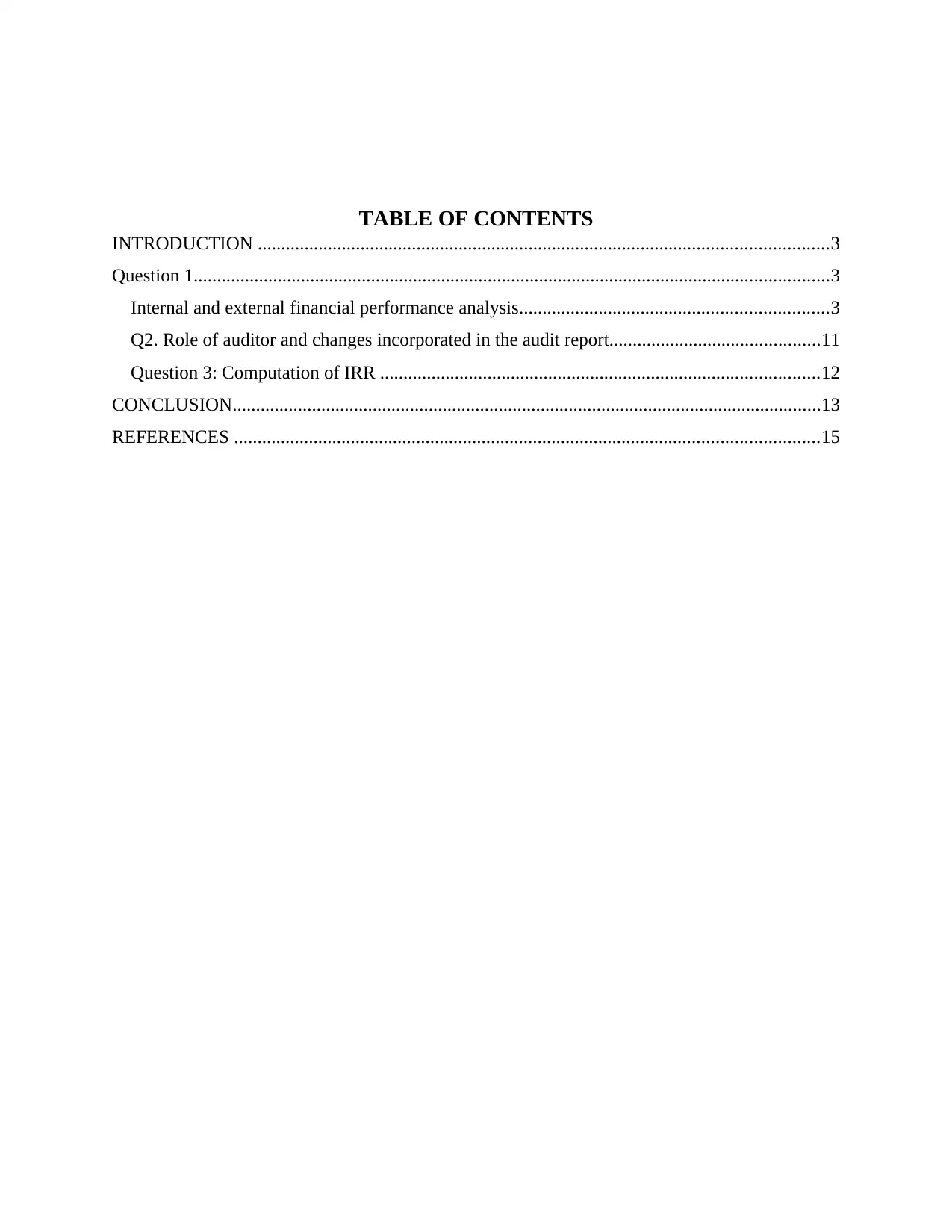
TABLE OF CONTENTS
INTRODUCTION ..........................................................................................................................3
Question 1........................................................................................................................................3
Internal and external financial performance analysis..................................................................3
Q2. Role of auditor and changes incorporated in the audit report.............................................11
Question 3: Computation of IRR ..............................................................................................12
CONCLUSION..............................................................................................................................13
REFERENCES .............................................................................................................................15
INTRODUCTION ..........................................................................................................................3
Question 1........................................................................................................................................3
Internal and external financial performance analysis..................................................................3
Q2. Role of auditor and changes incorporated in the audit report.............................................11
Question 3: Computation of IRR ..............................................................................................12
CONCLUSION..............................................................................................................................13
REFERENCES .............................................................................................................................15
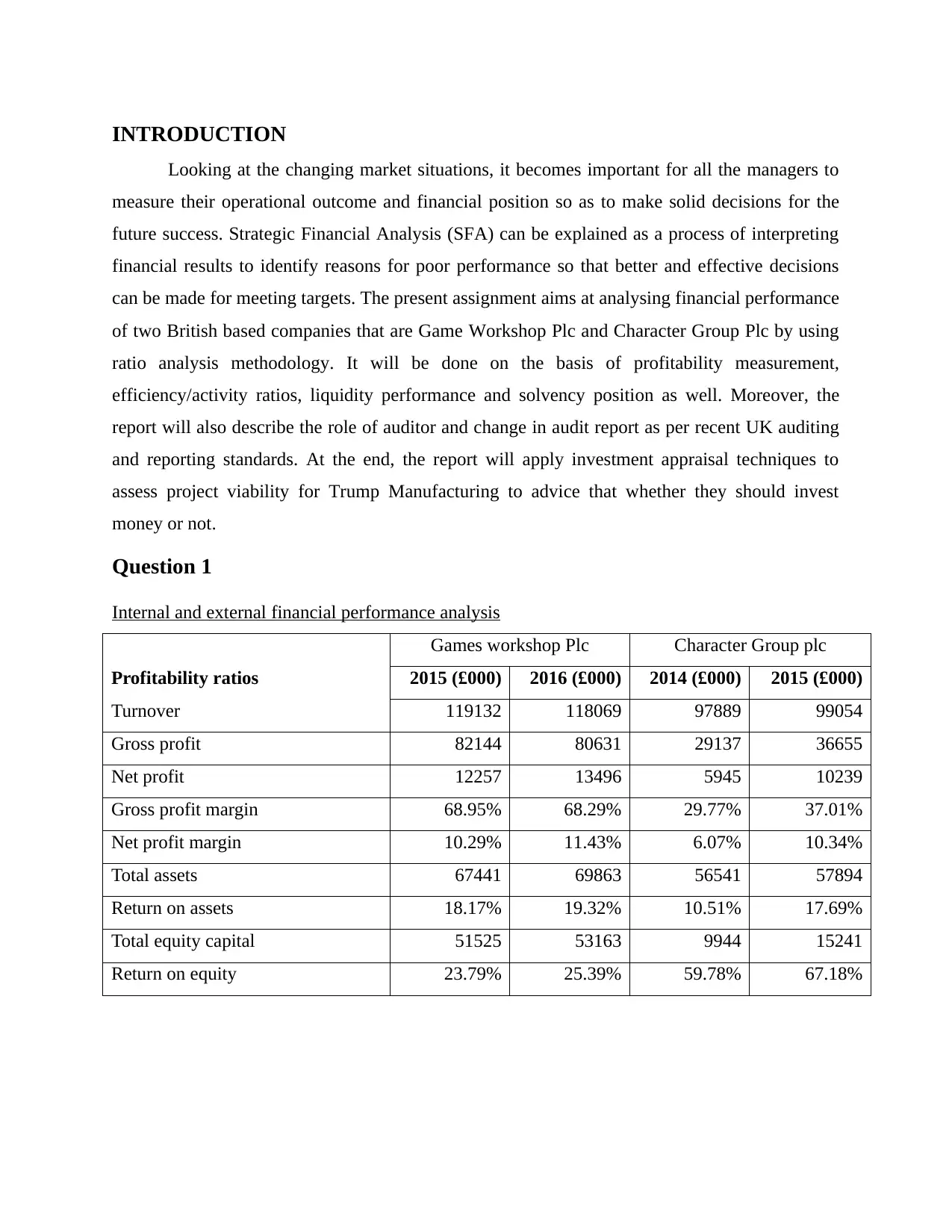
INTRODUCTION
Looking at the changing market situations, it becomes important for all the managers to
measure their operational outcome and financial position so as to make solid decisions for the
future success. Strategic Financial Analysis (SFA) can be explained as a process of interpreting
financial results to identify reasons for poor performance so that better and effective decisions
can be made for meeting targets. The present assignment aims at analysing financial performance
of two British based companies that are Game Workshop Plc and Character Group Plc by using
ratio analysis methodology. It will be done on the basis of profitability measurement,
efficiency/activity ratios, liquidity performance and solvency position as well. Moreover, the
report will also describe the role of auditor and change in audit report as per recent UK auditing
and reporting standards. At the end, the report will apply investment appraisal techniques to
assess project viability for Trump Manufacturing to advice that whether they should invest
money or not.
Question 1
Internal and external financial performance analysis
Profitability ratios
Games workshop Plc Character Group plc
2015 (£000) 2016 (£000) 2014 (£000) 2015 (£000)
Turnover 119132 118069 97889 99054
Gross profit 82144 80631 29137 36655
Net profit 12257 13496 5945 10239
Gross profit margin 68.95% 68.29% 29.77% 37.01%
Net profit margin 10.29% 11.43% 6.07% 10.34%
Total assets 67441 69863 56541 57894
Return on assets 18.17% 19.32% 10.51% 17.69%
Total equity capital 51525 53163 9944 15241
Return on equity 23.79% 25.39% 59.78% 67.18%
Looking at the changing market situations, it becomes important for all the managers to
measure their operational outcome and financial position so as to make solid decisions for the
future success. Strategic Financial Analysis (SFA) can be explained as a process of interpreting
financial results to identify reasons for poor performance so that better and effective decisions
can be made for meeting targets. The present assignment aims at analysing financial performance
of two British based companies that are Game Workshop Plc and Character Group Plc by using
ratio analysis methodology. It will be done on the basis of profitability measurement,
efficiency/activity ratios, liquidity performance and solvency position as well. Moreover, the
report will also describe the role of auditor and change in audit report as per recent UK auditing
and reporting standards. At the end, the report will apply investment appraisal techniques to
assess project viability for Trump Manufacturing to advice that whether they should invest
money or not.
Question 1
Internal and external financial performance analysis
Profitability ratios
Games workshop Plc Character Group plc
2015 (£000) 2016 (£000) 2014 (£000) 2015 (£000)
Turnover 119132 118069 97889 99054
Gross profit 82144 80631 29137 36655
Net profit 12257 13496 5945 10239
Gross profit margin 68.95% 68.29% 29.77% 37.01%
Net profit margin 10.29% 11.43% 6.07% 10.34%
Total assets 67441 69863 56541 57894
Return on assets 18.17% 19.32% 10.51% 17.69%
Total equity capital 51525 53163 9944 15241
Return on equity 23.79% 25.39% 59.78% 67.18%
⊘ This is a preview!⊘
Do you want full access?
Subscribe today to unlock all pages.

Trusted by 1+ million students worldwide
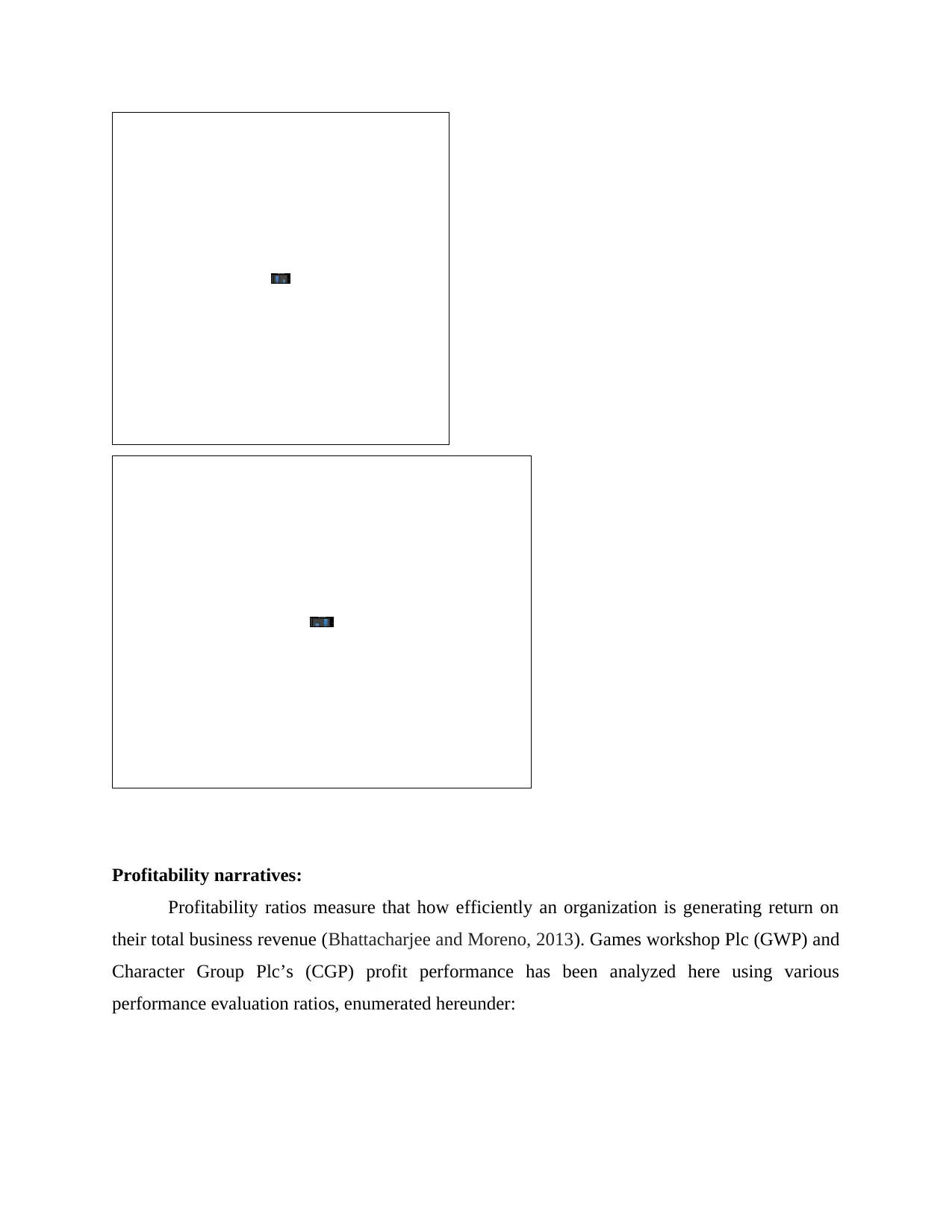
Profitability narratives:
Profitability ratios measure that how efficiently an organization is generating return on
their total business revenue (Bhattacharjee and Moreno, 2013). Games workshop Plc (GWP) and
Character Group Plc’s (CGP) profit performance has been analyzed here using various
performance evaluation ratios, enumerated hereunder:
Profitability ratios measure that how efficiently an organization is generating return on
their total business revenue (Bhattacharjee and Moreno, 2013). Games workshop Plc (GWP) and
Character Group Plc’s (CGP) profit performance has been analyzed here using various
performance evaluation ratios, enumerated hereunder:
Paraphrase This Document
Need a fresh take? Get an instant paraphrase of this document with our AI Paraphraser
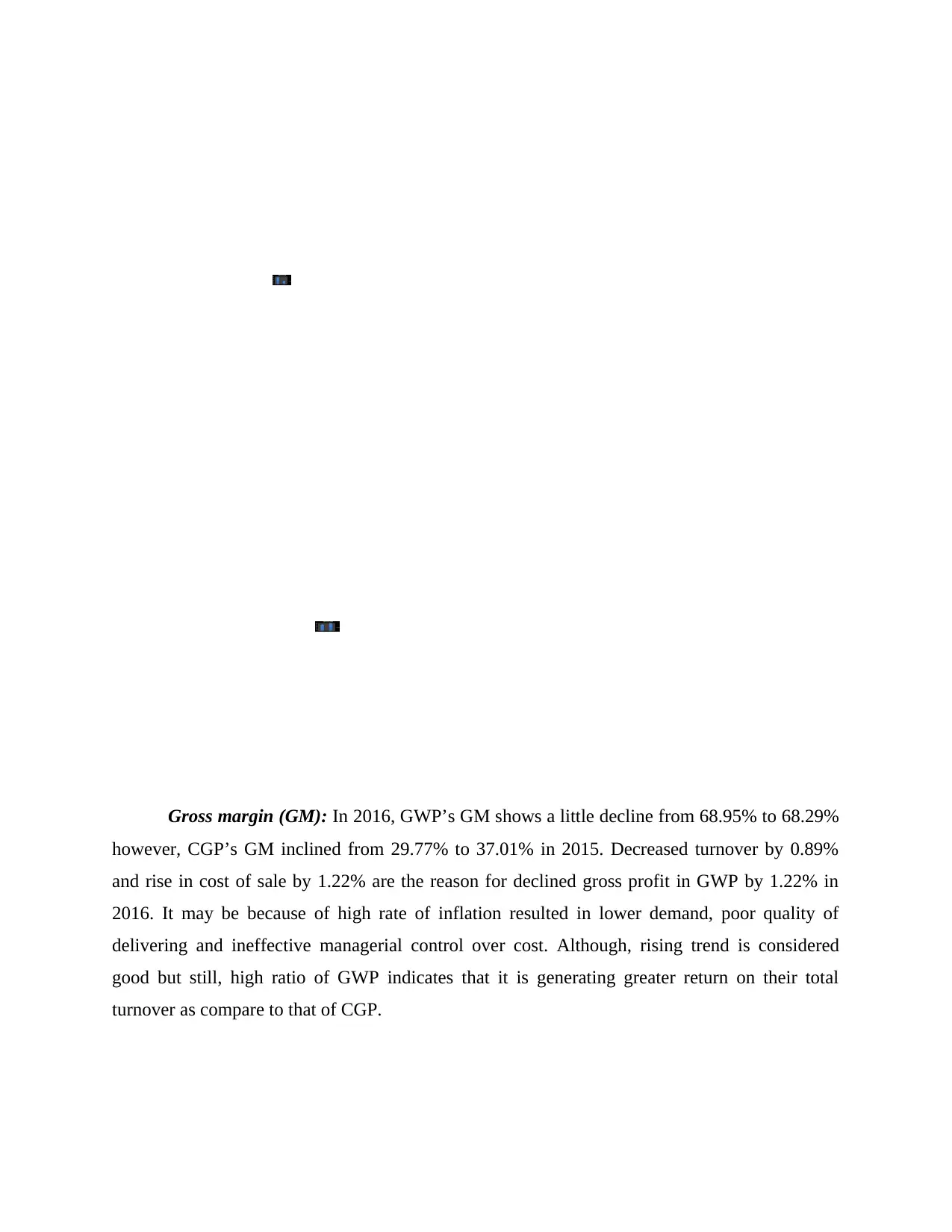
Gross margin (GM): In 2016, GWP’s GM shows a little decline from 68.95% to 68.29%
however, CGP’s GM inclined from 29.77% to 37.01% in 2015. Decreased turnover by 0.89%
and rise in cost of sale by 1.22% are the reason for declined gross profit in GWP by 1.22% in
2016. It may be because of high rate of inflation resulted in lower demand, poor quality of
delivering and ineffective managerial control over cost. Although, rising trend is considered
good but still, high ratio of GWP indicates that it is generating greater return on their total
turnover as compare to that of CGP.
however, CGP’s GM inclined from 29.77% to 37.01% in 2015. Decreased turnover by 0.89%
and rise in cost of sale by 1.22% are the reason for declined gross profit in GWP by 1.22% in
2016. It may be because of high rate of inflation resulted in lower demand, poor quality of
delivering and ineffective managerial control over cost. Although, rising trend is considered
good but still, high ratio of GWP indicates that it is generating greater return on their total
turnover as compare to that of CGP.
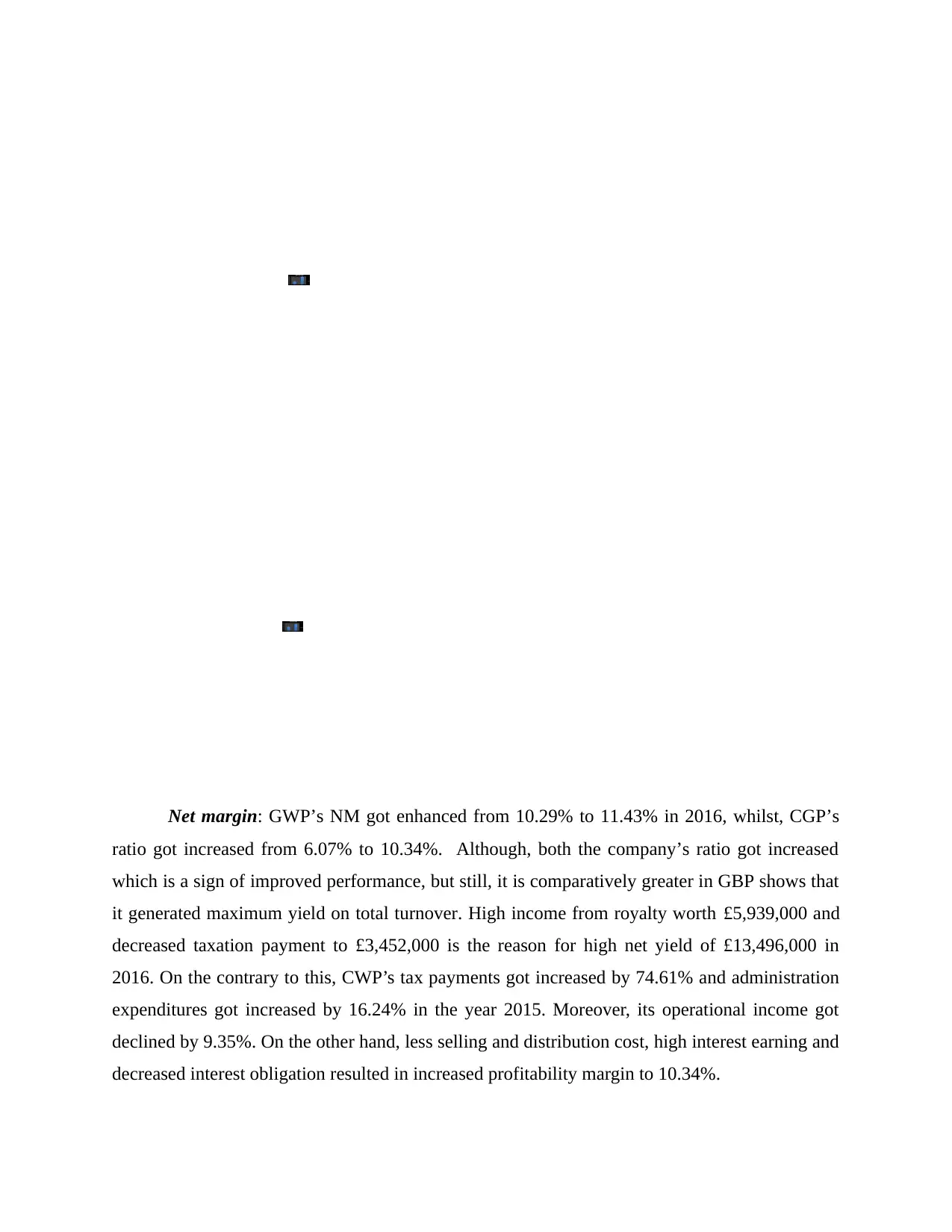
Net margin: GWP’s NM got enhanced from 10.29% to 11.43% in 2016, whilst, CGP’s
ratio got increased from 6.07% to 10.34%. Although, both the company’s ratio got increased
which is a sign of improved performance, but still, it is comparatively greater in GBP shows that
it generated maximum yield on total turnover. High income from royalty worth £5,939,000 and
decreased taxation payment to £3,452,000 is the reason for high net yield of £13,496,000 in
2016. On the contrary to this, CWP’s tax payments got increased by 74.61% and administration
expenditures got increased by 16.24% in the year 2015. Moreover, its operational income got
declined by 9.35%. On the other hand, less selling and distribution cost, high interest earning and
decreased interest obligation resulted in increased profitability margin to 10.34%.
ratio got increased from 6.07% to 10.34%. Although, both the company’s ratio got increased
which is a sign of improved performance, but still, it is comparatively greater in GBP shows that
it generated maximum yield on total turnover. High income from royalty worth £5,939,000 and
decreased taxation payment to £3,452,000 is the reason for high net yield of £13,496,000 in
2016. On the contrary to this, CWP’s tax payments got increased by 74.61% and administration
expenditures got increased by 16.24% in the year 2015. Moreover, its operational income got
declined by 9.35%. On the other hand, less selling and distribution cost, high interest earning and
decreased interest obligation resulted in increased profitability margin to 10.34%.
⊘ This is a preview!⊘
Do you want full access?
Subscribe today to unlock all pages.

Trusted by 1+ million students worldwide
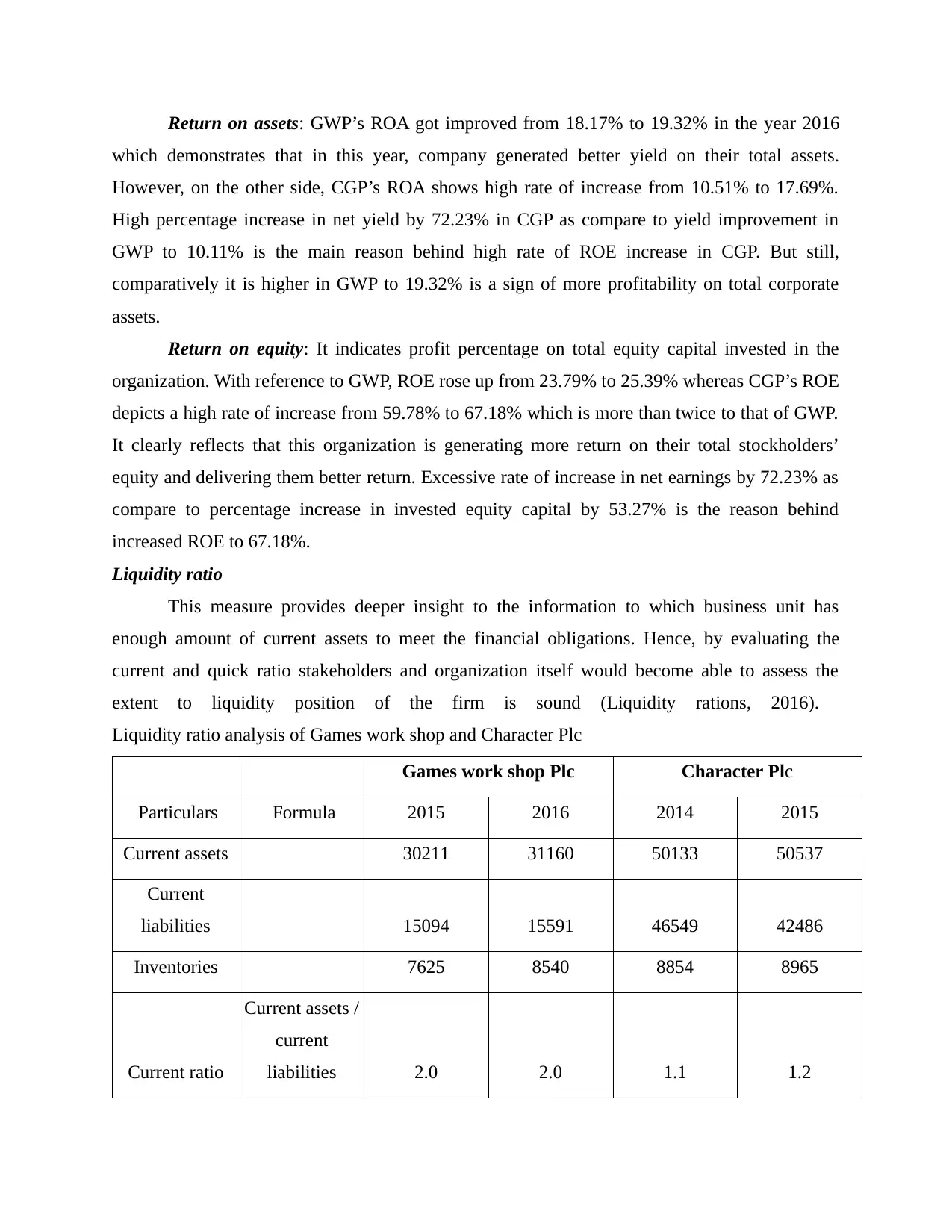
Return on assets: GWP’s ROA got improved from 18.17% to 19.32% in the year 2016
which demonstrates that in this year, company generated better yield on their total assets.
However, on the other side, CGP’s ROA shows high rate of increase from 10.51% to 17.69%.
High percentage increase in net yield by 72.23% in CGP as compare to yield improvement in
GWP to 10.11% is the main reason behind high rate of ROE increase in CGP. But still,
comparatively it is higher in GWP to 19.32% is a sign of more profitability on total corporate
assets.
Return on equity: It indicates profit percentage on total equity capital invested in the
organization. With reference to GWP, ROE rose up from 23.79% to 25.39% whereas CGP’s ROE
depicts a high rate of increase from 59.78% to 67.18% which is more than twice to that of GWP.
It clearly reflects that this organization is generating more return on their total stockholders’
equity and delivering them better return. Excessive rate of increase in net earnings by 72.23% as
compare to percentage increase in invested equity capital by 53.27% is the reason behind
increased ROE to 67.18%.
Liquidity ratio
This measure provides deeper insight to the information to which business unit has
enough amount of current assets to meet the financial obligations. Hence, by evaluating the
current and quick ratio stakeholders and organization itself would become able to assess the
extent to liquidity position of the firm is sound (Liquidity rations, 2016).
Liquidity ratio analysis of Games work shop and Character Plc
Games work shop Plc Character Plc
Particulars Formula 2015 2016 2014 2015
Current assets 30211 31160 50133 50537
Current
liabilities 15094 15591 46549 42486
Inventories 7625 8540 8854 8965
Current ratio
Current assets /
current
liabilities 2.0 2.0 1.1 1.2
which demonstrates that in this year, company generated better yield on their total assets.
However, on the other side, CGP’s ROA shows high rate of increase from 10.51% to 17.69%.
High percentage increase in net yield by 72.23% in CGP as compare to yield improvement in
GWP to 10.11% is the main reason behind high rate of ROE increase in CGP. But still,
comparatively it is higher in GWP to 19.32% is a sign of more profitability on total corporate
assets.
Return on equity: It indicates profit percentage on total equity capital invested in the
organization. With reference to GWP, ROE rose up from 23.79% to 25.39% whereas CGP’s ROE
depicts a high rate of increase from 59.78% to 67.18% which is more than twice to that of GWP.
It clearly reflects that this organization is generating more return on their total stockholders’
equity and delivering them better return. Excessive rate of increase in net earnings by 72.23% as
compare to percentage increase in invested equity capital by 53.27% is the reason behind
increased ROE to 67.18%.
Liquidity ratio
This measure provides deeper insight to the information to which business unit has
enough amount of current assets to meet the financial obligations. Hence, by evaluating the
current and quick ratio stakeholders and organization itself would become able to assess the
extent to liquidity position of the firm is sound (Liquidity rations, 2016).
Liquidity ratio analysis of Games work shop and Character Plc
Games work shop Plc Character Plc
Particulars Formula 2015 2016 2014 2015
Current assets 30211 31160 50133 50537
Current
liabilities 15094 15591 46549 42486
Inventories 7625 8540 8854 8965
Current ratio
Current assets /
current
liabilities 2.0 2.0 1.1 1.2
Paraphrase This Document
Need a fresh take? Get an instant paraphrase of this document with our AI Paraphraser
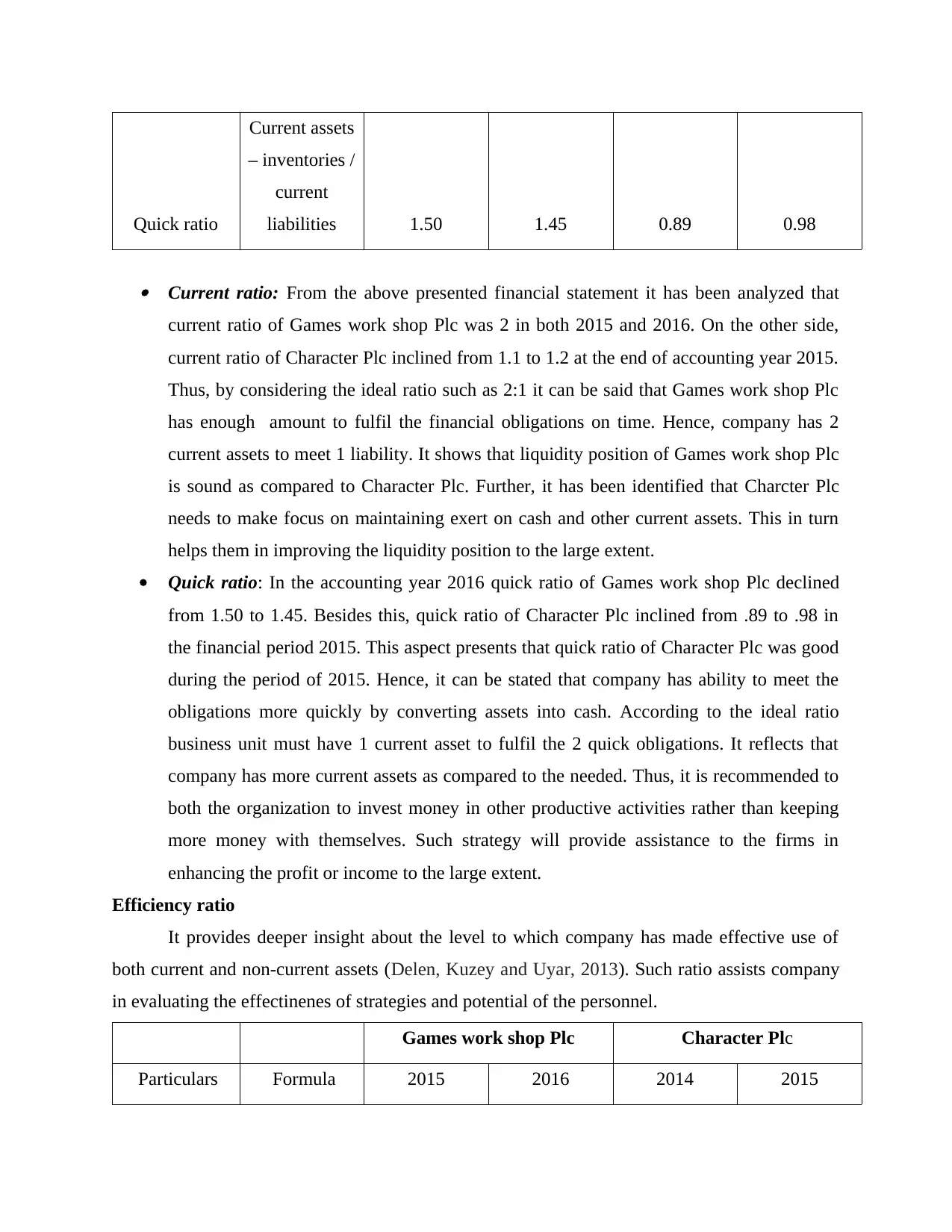
Quick ratio
Current assets
– inventories /
current
liabilities 1.50 1.45 0.89 0.98
Current ratio: From the above presented financial statement it has been analyzed that
current ratio of Games work shop Plc was 2 in both 2015 and 2016. On the other side,
current ratio of Character Plc inclined from 1.1 to 1.2 at the end of accounting year 2015.
Thus, by considering the ideal ratio such as 2:1 it can be said that Games work shop Plc
has enough amount to fulfil the financial obligations on time. Hence, company has 2
current assets to meet 1 liability. It shows that liquidity position of Games work shop Plc
is sound as compared to Character Plc. Further, it has been identified that Charcter Plc
needs to make focus on maintaining exert on cash and other current assets. This in turn
helps them in improving the liquidity position to the large extent.
Quick ratio: In the accounting year 2016 quick ratio of Games work shop Plc declined
from 1.50 to 1.45. Besides this, quick ratio of Character Plc inclined from .89 to .98 in
the financial period 2015. This aspect presents that quick ratio of Character Plc was good
during the period of 2015. Hence, it can be stated that company has ability to meet the
obligations more quickly by converting assets into cash. According to the ideal ratio
business unit must have 1 current asset to fulfil the 2 quick obligations. It reflects that
company has more current assets as compared to the needed. Thus, it is recommended to
both the organization to invest money in other productive activities rather than keeping
more money with themselves. Such strategy will provide assistance to the firms in
enhancing the profit or income to the large extent.
Efficiency ratio
It provides deeper insight about the level to which company has made effective use of
both current and non-current assets (Delen, Kuzey and Uyar, 2013). Such ratio assists company
in evaluating the effectinenes of strategies and potential of the personnel.
Games work shop Plc Character Plc
Particulars Formula 2015 2016 2014 2015
Current assets
– inventories /
current
liabilities 1.50 1.45 0.89 0.98
Current ratio: From the above presented financial statement it has been analyzed that
current ratio of Games work shop Plc was 2 in both 2015 and 2016. On the other side,
current ratio of Character Plc inclined from 1.1 to 1.2 at the end of accounting year 2015.
Thus, by considering the ideal ratio such as 2:1 it can be said that Games work shop Plc
has enough amount to fulfil the financial obligations on time. Hence, company has 2
current assets to meet 1 liability. It shows that liquidity position of Games work shop Plc
is sound as compared to Character Plc. Further, it has been identified that Charcter Plc
needs to make focus on maintaining exert on cash and other current assets. This in turn
helps them in improving the liquidity position to the large extent.
Quick ratio: In the accounting year 2016 quick ratio of Games work shop Plc declined
from 1.50 to 1.45. Besides this, quick ratio of Character Plc inclined from .89 to .98 in
the financial period 2015. This aspect presents that quick ratio of Character Plc was good
during the period of 2015. Hence, it can be stated that company has ability to meet the
obligations more quickly by converting assets into cash. According to the ideal ratio
business unit must have 1 current asset to fulfil the 2 quick obligations. It reflects that
company has more current assets as compared to the needed. Thus, it is recommended to
both the organization to invest money in other productive activities rather than keeping
more money with themselves. Such strategy will provide assistance to the firms in
enhancing the profit or income to the large extent.
Efficiency ratio
It provides deeper insight about the level to which company has made effective use of
both current and non-current assets (Delen, Kuzey and Uyar, 2013). Such ratio assists company
in evaluating the effectinenes of strategies and potential of the personnel.
Games work shop Plc Character Plc
Particulars Formula 2015 2016 2014 2015

Total assets 67441 69863 56541 57894
Net sales 119132 118069 97889 99054
Inventories 7625 8540 8854 8965
COGS 36988 37438 68752 62399
Asset turnover
ratio
Net sales / total
assets 1.77 1.69 1.73 1.71
Inventory
turnover ratio
COGS /
inventory 4.85 4.38 7.77 6.96
Asset turnover ratio: During the period of 2015 asset turnover ratio of Games work shop
Plc was 1.77, whereas it declined from 1.77 to 1.69 at the end of FY 2016. In contrast to
this, in 2015 asset turnover ratio decreased from 1.73 to 1.71. By considering this aspect
it can be stated that in 2015 Character Plc failed to make effectual use of total assets for
the generation of sales in comparison to the competitor. Thus, Games work shop Plc has
performed better in the year of 2015 over the rival firm. On the basis of this it is advised
to the higher management to encourage their workforce to make the best efforts while
performing the business activities and functions (van den End and Kruidhof, 2013). Inventory turnover ratio: This ratio revealed declining trend in the inventory turnover of
Games workshop Plc from 4.85 to 4.38. In addition to this, such measure of Character
group Plc also declined from 7.77 to 6.96 at the year ended 2015. Hence, it can be said
that inventories of Game workshop Plc are sold and replaced with the very high pace.
Thus, Character group Plc needs to make focus on the adoption of inventory control
techniques such as EOQ, JIT etc. (Tan and Floros, 2012). This in turn helps in reducing
the cost and thereby helps in attaining high level of profit margin.
Comparison of stock market performance of Games workshop plc and Character group plc
Share price of Games workshop plc is 584 GBP. It can be observed that share price of the
firm shares is continuously fluctuating at fast pace. Share price of the firm declined from the
month of the January to July 2016. In the month of January share price of the company was 600
and it reduced to 430 up to the month of July 2016. This means that price of the Games
workshop declined by the -28% over the mentioned time period. This huge decline in the firm
Net sales 119132 118069 97889 99054
Inventories 7625 8540 8854 8965
COGS 36988 37438 68752 62399
Asset turnover
ratio
Net sales / total
assets 1.77 1.69 1.73 1.71
Inventory
turnover ratio
COGS /
inventory 4.85 4.38 7.77 6.96
Asset turnover ratio: During the period of 2015 asset turnover ratio of Games work shop
Plc was 1.77, whereas it declined from 1.77 to 1.69 at the end of FY 2016. In contrast to
this, in 2015 asset turnover ratio decreased from 1.73 to 1.71. By considering this aspect
it can be stated that in 2015 Character Plc failed to make effectual use of total assets for
the generation of sales in comparison to the competitor. Thus, Games work shop Plc has
performed better in the year of 2015 over the rival firm. On the basis of this it is advised
to the higher management to encourage their workforce to make the best efforts while
performing the business activities and functions (van den End and Kruidhof, 2013). Inventory turnover ratio: This ratio revealed declining trend in the inventory turnover of
Games workshop Plc from 4.85 to 4.38. In addition to this, such measure of Character
group Plc also declined from 7.77 to 6.96 at the year ended 2015. Hence, it can be said
that inventories of Game workshop Plc are sold and replaced with the very high pace.
Thus, Character group Plc needs to make focus on the adoption of inventory control
techniques such as EOQ, JIT etc. (Tan and Floros, 2012). This in turn helps in reducing
the cost and thereby helps in attaining high level of profit margin.
Comparison of stock market performance of Games workshop plc and Character group plc
Share price of Games workshop plc is 584 GBP. It can be observed that share price of the
firm shares is continuously fluctuating at fast pace. Share price of the firm declined from the
month of the January to July 2016. In the month of January share price of the company was 600
and it reduced to 430 up to the month of July 2016. This means that price of the Games
workshop declined by the -28% over the mentioned time period. This huge decline in the firm
⊘ This is a preview!⊘
Do you want full access?
Subscribe today to unlock all pages.

Trusted by 1+ million students worldwide
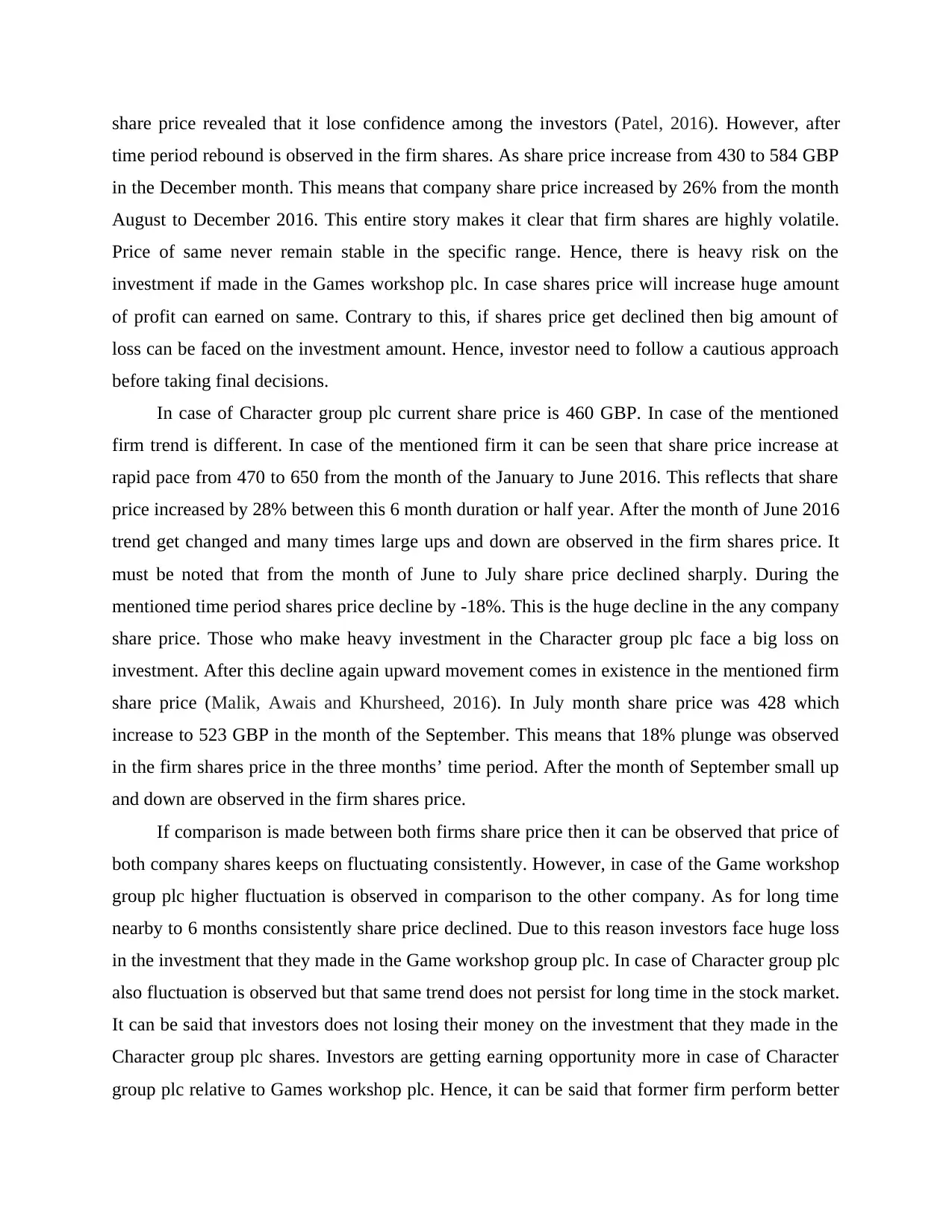
share price revealed that it lose confidence among the investors (Patel, 2016). However, after
time period rebound is observed in the firm shares. As share price increase from 430 to 584 GBP
in the December month. This means that company share price increased by 26% from the month
August to December 2016. This entire story makes it clear that firm shares are highly volatile.
Price of same never remain stable in the specific range. Hence, there is heavy risk on the
investment if made in the Games workshop plc. In case shares price will increase huge amount
of profit can earned on same. Contrary to this, if shares price get declined then big amount of
loss can be faced on the investment amount. Hence, investor need to follow a cautious approach
before taking final decisions.
In case of Character group plc current share price is 460 GBP. In case of the mentioned
firm trend is different. In case of the mentioned firm it can be seen that share price increase at
rapid pace from 470 to 650 from the month of the January to June 2016. This reflects that share
price increased by 28% between this 6 month duration or half year. After the month of June 2016
trend get changed and many times large ups and down are observed in the firm shares price. It
must be noted that from the month of June to July share price declined sharply. During the
mentioned time period shares price decline by -18%. This is the huge decline in the any company
share price. Those who make heavy investment in the Character group plc face a big loss on
investment. After this decline again upward movement comes in existence in the mentioned firm
share price (Malik, Awais and Khursheed, 2016). In July month share price was 428 which
increase to 523 GBP in the month of the September. This means that 18% plunge was observed
in the firm shares price in the three months’ time period. After the month of September small up
and down are observed in the firm shares price.
If comparison is made between both firms share price then it can be observed that price of
both company shares keeps on fluctuating consistently. However, in case of the Game workshop
group plc higher fluctuation is observed in comparison to the other company. As for long time
nearby to 6 months consistently share price declined. Due to this reason investors face huge loss
in the investment that they made in the Game workshop group plc. In case of Character group plc
also fluctuation is observed but that same trend does not persist for long time in the stock market.
It can be said that investors does not losing their money on the investment that they made in the
Character group plc shares. Investors are getting earning opportunity more in case of Character
group plc relative to Games workshop plc. Hence, it can be said that former firm perform better
time period rebound is observed in the firm shares. As share price increase from 430 to 584 GBP
in the December month. This means that company share price increased by 26% from the month
August to December 2016. This entire story makes it clear that firm shares are highly volatile.
Price of same never remain stable in the specific range. Hence, there is heavy risk on the
investment if made in the Games workshop plc. In case shares price will increase huge amount
of profit can earned on same. Contrary to this, if shares price get declined then big amount of
loss can be faced on the investment amount. Hence, investor need to follow a cautious approach
before taking final decisions.
In case of Character group plc current share price is 460 GBP. In case of the mentioned
firm trend is different. In case of the mentioned firm it can be seen that share price increase at
rapid pace from 470 to 650 from the month of the January to June 2016. This reflects that share
price increased by 28% between this 6 month duration or half year. After the month of June 2016
trend get changed and many times large ups and down are observed in the firm shares price. It
must be noted that from the month of June to July share price declined sharply. During the
mentioned time period shares price decline by -18%. This is the huge decline in the any company
share price. Those who make heavy investment in the Character group plc face a big loss on
investment. After this decline again upward movement comes in existence in the mentioned firm
share price (Malik, Awais and Khursheed, 2016). In July month share price was 428 which
increase to 523 GBP in the month of the September. This means that 18% plunge was observed
in the firm shares price in the three months’ time period. After the month of September small up
and down are observed in the firm shares price.
If comparison is made between both firms share price then it can be observed that price of
both company shares keeps on fluctuating consistently. However, in case of the Game workshop
group plc higher fluctuation is observed in comparison to the other company. As for long time
nearby to 6 months consistently share price declined. Due to this reason investors face huge loss
in the investment that they made in the Game workshop group plc. In case of Character group plc
also fluctuation is observed but that same trend does not persist for long time in the stock market.
It can be said that investors does not losing their money on the investment that they made in the
Character group plc shares. Investors are getting earning opportunity more in case of Character
group plc relative to Games workshop plc. Hence, it can be said that former firm perform better
Paraphrase This Document
Need a fresh take? Get an instant paraphrase of this document with our AI Paraphraser
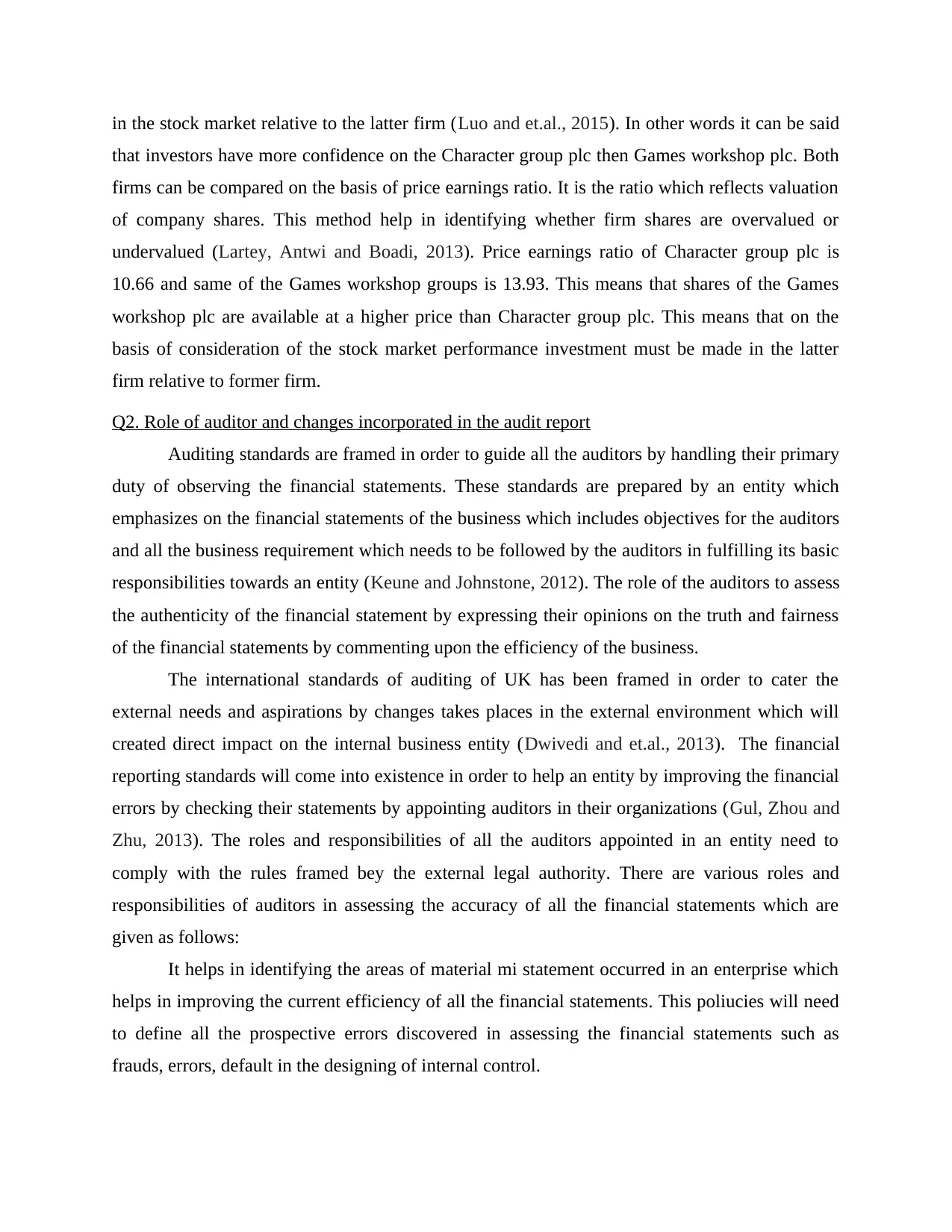
in the stock market relative to the latter firm (Luo and et.al., 2015). In other words it can be said
that investors have more confidence on the Character group plc then Games workshop plc. Both
firms can be compared on the basis of price earnings ratio. It is the ratio which reflects valuation
of company shares. This method help in identifying whether firm shares are overvalued or
undervalued (Lartey, Antwi and Boadi, 2013). Price earnings ratio of Character group plc is
10.66 and same of the Games workshop groups is 13.93. This means that shares of the Games
workshop plc are available at a higher price than Character group plc. This means that on the
basis of consideration of the stock market performance investment must be made in the latter
firm relative to former firm.
Q2. Role of auditor and changes incorporated in the audit report
Auditing standards are framed in order to guide all the auditors by handling their primary
duty of observing the financial statements. These standards are prepared by an entity which
emphasizes on the financial statements of the business which includes objectives for the auditors
and all the business requirement which needs to be followed by the auditors in fulfilling its basic
responsibilities towards an entity (Keune and Johnstone, 2012). The role of the auditors to assess
the authenticity of the financial statement by expressing their opinions on the truth and fairness
of the financial statements by commenting upon the efficiency of the business.
The international standards of auditing of UK has been framed in order to cater the
external needs and aspirations by changes takes places in the external environment which will
created direct impact on the internal business entity (Dwivedi and et.al., 2013). The financial
reporting standards will come into existence in order to help an entity by improving the financial
errors by checking their statements by appointing auditors in their organizations (Gul, Zhou and
Zhu, 2013). The roles and responsibilities of all the auditors appointed in an entity need to
comply with the rules framed bey the external legal authority. There are various roles and
responsibilities of auditors in assessing the accuracy of all the financial statements which are
given as follows:
It helps in identifying the areas of material mi statement occurred in an enterprise which
helps in improving the current efficiency of all the financial statements. This poliucies will need
to define all the prospective errors discovered in assessing the financial statements such as
frauds, errors, default in the designing of internal control.
that investors have more confidence on the Character group plc then Games workshop plc. Both
firms can be compared on the basis of price earnings ratio. It is the ratio which reflects valuation
of company shares. This method help in identifying whether firm shares are overvalued or
undervalued (Lartey, Antwi and Boadi, 2013). Price earnings ratio of Character group plc is
10.66 and same of the Games workshop groups is 13.93. This means that shares of the Games
workshop plc are available at a higher price than Character group plc. This means that on the
basis of consideration of the stock market performance investment must be made in the latter
firm relative to former firm.
Q2. Role of auditor and changes incorporated in the audit report
Auditing standards are framed in order to guide all the auditors by handling their primary
duty of observing the financial statements. These standards are prepared by an entity which
emphasizes on the financial statements of the business which includes objectives for the auditors
and all the business requirement which needs to be followed by the auditors in fulfilling its basic
responsibilities towards an entity (Keune and Johnstone, 2012). The role of the auditors to assess
the authenticity of the financial statement by expressing their opinions on the truth and fairness
of the financial statements by commenting upon the efficiency of the business.
The international standards of auditing of UK has been framed in order to cater the
external needs and aspirations by changes takes places in the external environment which will
created direct impact on the internal business entity (Dwivedi and et.al., 2013). The financial
reporting standards will come into existence in order to help an entity by improving the financial
errors by checking their statements by appointing auditors in their organizations (Gul, Zhou and
Zhu, 2013). The roles and responsibilities of all the auditors appointed in an entity need to
comply with the rules framed bey the external legal authority. There are various roles and
responsibilities of auditors in assessing the accuracy of all the financial statements which are
given as follows:
It helps in identifying the areas of material mi statement occurred in an enterprise which
helps in improving the current efficiency of all the financial statements. This poliucies will need
to define all the prospective errors discovered in assessing the financial statements such as
frauds, errors, default in the designing of internal control.
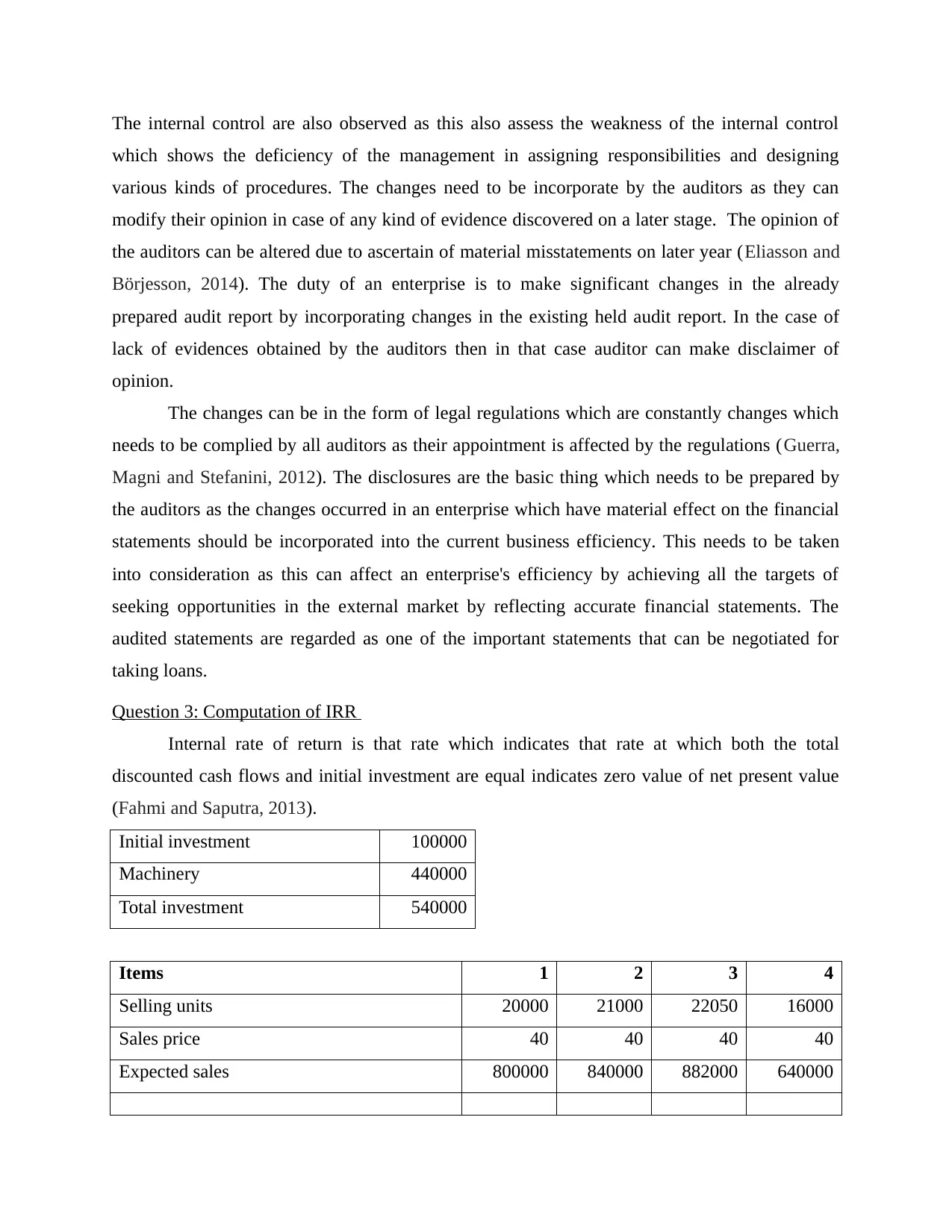
The internal control are also observed as this also assess the weakness of the internal control
which shows the deficiency of the management in assigning responsibilities and designing
various kinds of procedures. The changes need to be incorporate by the auditors as they can
modify their opinion in case of any kind of evidence discovered on a later stage. The opinion of
the auditors can be altered due to ascertain of material misstatements on later year (Eliasson and
Börjesson, 2014). The duty of an enterprise is to make significant changes in the already
prepared audit report by incorporating changes in the existing held audit report. In the case of
lack of evidences obtained by the auditors then in that case auditor can make disclaimer of
opinion.
The changes can be in the form of legal regulations which are constantly changes which
needs to be complied by all auditors as their appointment is affected by the regulations (Guerra,
Magni and Stefanini, 2012). The disclosures are the basic thing which needs to be prepared by
the auditors as the changes occurred in an enterprise which have material effect on the financial
statements should be incorporated into the current business efficiency. This needs to be taken
into consideration as this can affect an enterprise's efficiency by achieving all the targets of
seeking opportunities in the external market by reflecting accurate financial statements. The
audited statements are regarded as one of the important statements that can be negotiated for
taking loans.
Question 3: Computation of IRR
Internal rate of return is that rate which indicates that rate at which both the total
discounted cash flows and initial investment are equal indicates zero value of net present value
(Fahmi and Saputra, 2013).
Initial investment 100000
Machinery 440000
Total investment 540000
Items 1 2 3 4
Selling units 20000 21000 22050 16000
Sales price 40 40 40 40
Expected sales 800000 840000 882000 640000
which shows the deficiency of the management in assigning responsibilities and designing
various kinds of procedures. The changes need to be incorporate by the auditors as they can
modify their opinion in case of any kind of evidence discovered on a later stage. The opinion of
the auditors can be altered due to ascertain of material misstatements on later year (Eliasson and
Börjesson, 2014). The duty of an enterprise is to make significant changes in the already
prepared audit report by incorporating changes in the existing held audit report. In the case of
lack of evidences obtained by the auditors then in that case auditor can make disclaimer of
opinion.
The changes can be in the form of legal regulations which are constantly changes which
needs to be complied by all auditors as their appointment is affected by the regulations (Guerra,
Magni and Stefanini, 2012). The disclosures are the basic thing which needs to be prepared by
the auditors as the changes occurred in an enterprise which have material effect on the financial
statements should be incorporated into the current business efficiency. This needs to be taken
into consideration as this can affect an enterprise's efficiency by achieving all the targets of
seeking opportunities in the external market by reflecting accurate financial statements. The
audited statements are regarded as one of the important statements that can be negotiated for
taking loans.
Question 3: Computation of IRR
Internal rate of return is that rate which indicates that rate at which both the total
discounted cash flows and initial investment are equal indicates zero value of net present value
(Fahmi and Saputra, 2013).
Initial investment 100000
Machinery 440000
Total investment 540000
Items 1 2 3 4
Selling units 20000 21000 22050 16000
Sales price 40 40 40 40
Expected sales 800000 840000 882000 640000
⊘ This is a preview!⊘
Do you want full access?
Subscribe today to unlock all pages.

Trusted by 1+ million students worldwide
1 out of 16
Your All-in-One AI-Powered Toolkit for Academic Success.
+13062052269
info@desklib.com
Available 24*7 on WhatsApp / Email
![[object Object]](/_next/static/media/star-bottom.7253800d.svg)
Unlock your academic potential
Copyright © 2020–2025 A2Z Services. All Rights Reserved. Developed and managed by ZUCOL.